Polish złoty
| Polski złoty (Polish) zł | |||||
|---|---|---|---|---|---|
| |||||
| ISO 4217 | |||||
| Code | PLN (numeric: 985) | ||||
| Subunit | 0.01 | ||||
| Unit | |||||
| Unit | złoty | ||||
| Plural | See Name and plural forms | ||||
| Symbol | zł | ||||
| Denominations | |||||
| Subunit | |||||
| 1⁄100 | grosz | ||||
| Symbol | |||||
| grosz | gr | ||||
| Banknotes | |||||
| Freq. used | 10 zł, 20 zł, 50 zł, 100 zł, 200 zł | ||||
| Rarely used | 19 zł, 500 zł | ||||
| Coins | 1 gr, 2 gr, 5 gr, 10 gr, 20 gr, 50 gr, 1 zł, 2 zł, 5 zł | ||||
| Demographics | |||||
| Replaced | Polish marka | ||||
| User(s) | |||||
| Issuance | |||||
| Central bank | National Bank of Poland | ||||
| Website | www | ||||
| Mint | Polish Security Printing Works Mennica Polska | ||||
| Website | |||||
| Valuation | |||||
| Inflation | 5.00% (Trading Economics, October 2024) | ||||
| Method | CPI | ||||
The Polish złoty (alternative spelling: zloty;[1] Polish: polski złoty, Polish: [ˈzwɔtɨ] ;[a] abbreviation: zł; code: PLN)[b] is the official currency and legal tender of Poland. It is subdivided into 100 grosz (gr).[c] It is the most traded currency in Central and Eastern Europe and ranks 21st most-traded in the foreign exchange market.[2][3]
The word złoty is a masculine form of the Polish adjective 'golden', which closely relates with its name to the guilder whereas the grosz subunit was based on the groschen, cognate to the English word groat. It was officially introduced to replace its predecessor, the Polish marka, on 28 February 1919 and began circulation in 1924. The only bodies permitted to manufacture or mint złoty coins and banknotes are Polish Security Printing Works (PWPW), founded in Warsaw on 25 January 1919, and Mennica Polska, founded in Warsaw on 10 February 1766.
As a result of inflation in the early 1990s, the currency underwent redenomination. Thus, on 1 January 1995, 10,000 old złoty (PLZ) became one new złoty (PLN). As a member of the European Union, Poland is obligated to adopt the euro when all specific conditions are met, however there is no time limit for fulfilling all of them.
Currently, Poland is not in ERM II.
Name and plural forms
[edit]The term "złoty" is an adjective derived from the noun "złoto", which in the Polish language denotes gold. A literal translation of the currency's name would be "golden" or "the golden one". There are two plural forms – złote [ˈzwɔtɛ] as well as złotych [ˈzwɔtɨx], and their correct usage is as follows:[4]
- 1 – złoty or grosz [ˈzwɔtɨ] / [ˈɡrɔʂ]
- 2...4; 22...24; 32...34 (...), 102...104, 122...124, 132...134, (...) – złote or grosze Polish pronunciation: [ˈzwɔtɛ] / Polish pronunciation: [ˈɡrɔʂɛ]
- 0, 5...21; 25...31; 35...41 (...); 95...101; 105...121; 125...131; (...) – złotych or groszy Polish pronunciation: [ˈzwɔtɨx] / Polish pronunciation: [ˈɡrɔʂɨ]
Fractions should be rendered with złotego [zwɔˈtɛɡɔ] and grosza [ˈɡrɔʂa], for example 0.1 złotego; 2.5 złotego and so on.
Native English speakers or English-language sources tend to avoid the complexity of plural forms and in turn use "złoty" for all denominations, for instance 2 złoty and 100 złoty instead of 2 złote and 100 złotych.[citation needed]
Symbol
[edit]
zł key (shared with ; symbol) in the top row.The official currency symbol is zł, composed of lowercase z and ł which are the two first letters of "złoty".[5] It has no representation in the Unicode Standard as a single sign, but previously it had representation in Polish typewriters and computers.[6] The symbol of the "grosz" subunit is represented by lowercase gr.[7]
History
[edit]First złoty
[edit]
The first form of tangible currency in Poland was the denarius (denar), which circulated since the 10th century.[8] During this period, Polish coinage had a single face value and was minted from bullion, primarily silver, but also compounded with copper and other precious metals.[9] The standard unit of mass used at the time was the grzywna rather than the pound, with one grzywna being equivalent to 240 denars.[10] From the 1300s to the mid-16th century, the Prague groschen (or groat) dominated the market and its high supply reduced the demand for a national currency across Central Europe.[11] Certain cities and autonomous regions of the Polish Kingdom held the privilege of minting its own currency, for instance the shilling (szeląg) in the Duchy of Prussia, which Poland co-adopted in 1526.[12]
Initially, the term "złoty" (lit. the golden one) was used in the 14th and 15th centuries for a number of foreign gold coins, most notably Venetian ducats, florins and guldens. In 1496, the Sejm parliament debated on the creation of a domestic currency and approved the złoty, which until then acted as a unit of account.[13] An exchange rate of 30 grosz was imposed for one gold piece, which remained the traditional subdivision until the 19th century.[14] In the years 1526–1535, as part of an extensive monetary reform proposed by Nicolaus Copernicus and Justus Decius, king Sigismund I defined the złoty as a legal tender in the minting ordinance on 16 February 1528.[15]

The Polish monetary system stayed complex and intricate from the 16th to 18th centuries until a monetary reform was done by Stanisław II Augustus which removed all other monetary units except the złoty divided into 30 groszy. Polish currency was then linked to that of the Holy Roman Empire by setting the Conventionsthaler = 8 złoty = 23.3856 g fine silver and the North German thaler = 6 złoty = 17.5392 g silver (hence 2.9232 g silver in a złoty).
Radical changes to the currency were made during the Kościuszko Uprising. The second partition of the vast Polish–Lithuanian Commonwealth resulted in the loss of approximately 200,000 square kilometres of land and precipitated an economic collapse. The widespread shortage of funds to finance the defense of remaining territories forced the insurrectionist government to look for alternatives. In June 1794, Tadeusz Kościuszko began printing paper money and issuing first Polish banknotes as a substitute for coinage, which could not be minted in required quantities.[16] These entered circulation on 13 August 1794.
The złoty remained in circulation after the Partitions of Poland and Napoleon's Duchy of Warsaw issued coins denominated in grosz, złoty and talars, with the talar (thaler) of 6 złoty slightly reduced in value to the Prussian thaler of 16.704 g fine silver (hence 2.784 g silver in a złoty).[17] Talar banknotes were also issued. In 1813, while Zamość was under siege, the town authorities issued 6 grosz and 2 złoty coins. Following the 1815 Congress of Vienna, Austrian and Russian sectors of partitioned Poland continued to use the złoty for some time; whereas the German sector replaced the talar and złoty with the Prussian thaler and afterwards the German gold mark.
On 19 November O.S. (1 December N.S.) 1815, the law regarding the monetary system of Congress Poland (in Russia) was passed, which pegged the złoty at 15 kopecks (0.15 Imperial roubles, or almost 2.7 g fine silver) and the groszy at 1⁄2 kopeck, and with silver 1, 2, 5 and 10 złotych coins issued from 1816 to 1855.
At the time of the 1830 November Uprising, the insurrectionists issued their own "rebel money" – golden ducats and silver coins in the denomination of 2 and 5 złoty, with the revolutionary coat of arms, and the copper 3 and 10 grosz.[18] These coins were still traded long after the uprising was quelled. As a consequence of the uprising, the rubel became the sole legal tender of Congress Poland since 1842, although coins marked as złoty in parallel with ruble were minted in Warsaw until 1865 and remained legal until 1890. In 1892 the Austro-Hungarian krone was introduced in Austrian Galicia. Between 1835 and 1846, the Free City of Kraków also used its own independent currency, the Kraków złoty, with the coins actually being made in Vienna, it remained legal until 1857.
During World War I, the rouble and krone were replaced by the Polish marka, a currency initially equivalent to the German mark. The marka stayed in use after Poland regained its independence in 1918, but was extremely unstable, disrupted the whole economy, and triggered galloping inflation.
Second złoty
[edit]

The złoty was reintroduced by the Minister of Finance, Władysław Grabski, in April 1924.[19] It replaced the marka at a rate of 1 złoty equaling 1,800,000 marks and was subdivided into 100 grosz, instead of the traditional 30 grosz, as it had been earlier.[20]
Following its inauguration, the second złoty was pegged to the United States dollar through a stabilization loan provided by the Federal Reserve Bank of New York.[21] The budget deficit ballooned and out-of-control inflation ensued. The złoty began to stabilise in 1926 (chiefly due to significant exports of coal),[22] and was re-set on the dollar-złoty rate 50% higher than in 1924. Up to 1933 the złoty was freely exchanged into gold and foreign currency. Based on these developments, the Polish government made the decision to adopt the gold standard and maintain it for a significant period to attract global investors.[23]
Under the occupation during World War II, the Germans created an Emissary Bank (Bank Emisyjny) in Kraków, as Polish bank officials fled to Paris in France.[24] It started operating on 8 April 1940, and in May old banknotes from 1924 to 1939 were overstamped by the new entity.[25] Money exchange was limited per individual; the limits varied according to the status of the person. The fixed exchange rate was 2 złoty per 1 Reichsmark.[26] A new issue of notes appeared in the years 1940–1941.[27]
On 15 January 1945 the National Bank of Poland was formed, and a new printing plant opened in Łódź.[28] The series II and III notes were designed by Ryszard Kleczewski and Wacław Borowski. The first three series were taken out of circulation in line with legislation signed on 28 October 1950, covering the introduction of a new złoty with a revived coinage system.[29]
Third złoty (PLZ)
[edit]In 1950, the third złoty (PLZ) was introduced, replacing all notes issued up to 1948 at a rate of one hundred to one, while all bank assets were re-denominated in the ratio 100:3. The new banknotes were dated in 1948, while the new coins were dated in 1949. Initially, by law with effect from 1950 1 złoty was worth 0.222168 grams of pure gold.[30] The banknotes went from 10 zlotych all the way to 5 million zlotych.[31]
Fourth złoty (PLN)
[edit]With the fall of communism in 1989 and successive hyperinflation in 1990, the złoty had to be redenominated. On 11 May 1994, a redenomination project from the NBP was approved; the act allowing the project to come into force was ratified on 7 July 1994.[32] Thus, on 1 January 1995 the old 10,000 PLZ became the new 1 PLN.[26] Redesigned coins and banknotes were released, featuring Polish monarchs, which were printed by De La Rue in London (until 1997) and PWPW in Warsaw (from 1997).[33]
Between 2013 and 2014, the banknotes received additional security features. The design does not differ greatly from the original 1994 series, but are distinguishable by the added white-coloured field with a watermark on the obverse. The updated notes also possess randomly arranged dotting, which are part of the EURion constellation.[34]
On 10 February 2017, a 500zł banknote with the likeness of John III Sobieski began circulating.[35] On 2 October 2019, the 19 złotych note was released.[36] In 2021, Adam Glapiński, president of the National Bank of Poland, announced that a 1000zł note will be introduced in the near future.[37]
Future of the złoty
[edit]One of the conditions of Poland's joining the European Union in May 2004 obliges the country to eventually adopt the euro, though not at any specific date and only after Poland meets the necessary stability criteria. Serious discussions regarding joining the Eurozone have ensued.[38][39][40] Article 227[41] of the Constitution of the Republic of Poland will need to be amended first.[42] While opinion on the euro has not always been in favor, 2022 opinion polling on behalf of the European Commission found around 60% support for adopting the Euro.[43]
Banknotes
[edit]The banknotes range from 12 to 15 centimetres in length and from 60 to 75 millimetres in width. The length increases by 6mm and the width by 3mm with every higher denomination. The obverse features the left profile of a Polish monarch clothed in armour or royal regalia; the sovereigns are arranged chronologically based on the period of reign. The reverse illustrates important landmarks, early coinage or important objects from Poland's history. Architectural elements comprising portals, columns, windows or flower motifs are scattered throughout each banknote, both on the obverse and on the reverse. Predominant colours used include shades of brown, pink or purple, blue, green and gold. Face value is given in numerals in the upper-left and upper-right corners on the obverse, and in the upper-right corner on the reverse. The written form of the nominal value is embedded vertically on the obverse and horizontally on the reverse.[34]
The notes are adorned by the shieldless coat of arms of the Republic of Poland, along with signatures of the President and General Treasurer of NBP – the National Bank of Poland.[34]
| Image | Value | Dimensions | Main colours | Description | Date of | ||||
|---|---|---|---|---|---|---|---|---|---|
| Obverse | Reverse | Obverse | Reverse | series | circulation | ||||
| 10 złotych | 120 × 60 mm | Brown | Mieszko I | Denarius coin Romanesque columns from the Tyniec Abbey |
1994
2012 |
1 January 1995
7 April 2014 | |||
| 20 złotych | 126 × 63 mm | Pink, purple | Boleslaus I the Brave | Denarius coin Rotunda of Saint Nicolas and a fragment of Gniezno Doors |
1994
2012 |
1 January 1995
7 April 2014 | |||
| 50 złotych | 132 × 66 mm | Blue | Casimir III the Great | Polish white eagle with royal regalia Kraków and Kazimierz by Hartmann Schedel |
1994
2012 |
1 January 1995
7 April 2014 | |||
| 100 złotych | 138 × 69 mm | Green | Władysław II Jagiełło (Jogaila) | Polish white eagle with Grunwald swords and Teutonic armour Malbork Castle |
1994
2012 |
1 January 1995
7 April 2014 | |||

|
200 złotych | 144 × 72 mm | Gold, yellow | Sigismund I the Old | Polish white eagle from the Sigismund's Chapel Wawel Castle |
1994
2015 |
1 January 1995
12 February 2016 | ||
| 500 złotych | 150 × 75 mm | Light blue, pink, gold and brown | John III Sobieski | Polish white eagle Wilanów Palace |
2016 | 10 February 2017 | |||
Exchange rates
[edit]
| Year | USD | EUR | DEM | GBP | CHF | JPY | BTC |
|---|---|---|---|---|---|---|---|
| 1990 | 9500.00 | 12070.50 | 5864.19 | 16862.50 | 6884.05 | 65.45 | |
| 1991 | 10584.26 | 13088.29 | 6378.62 | 18652.81 | 7379.05 | 78.7235 | |
| 1992 | 13630.12 | 17662.35 | 8761.51 | 24009.90 | 9742.76 | 107.7766 | |
| 1993 | 18164.84 | 21204.91 | 10975.20 | 27274.86 | 12308.00 | 164.16 | |
| 1994 | 22726.95 | 26913.49 | 14049.60 | 34772.23 | 16670.93 | 224.16 | |
| Re-denomination (10000:1) | |||||||
| 1995 | 2.4244 | 3.1358 | 1.6928 | 3.8257 | 2.0545 | 0.0258 | |
| 1996 | 2.6965 | 3.3774 | 1.7920 | 4.2154 | 2.1826 | 0.0248 | |
| 1997 | 3.2808 | 3.7055 | 1.8918 | 5.3751 | 2.2627 | 0.0272 | |
| 1998 | 3.4937 | 3.9231 | 1.9888 | 5.7907 | 2.4149 | 0.0268 | |
| 1999 | 3.9675 | 4.2270 | 2.1612 | 6.4197 | 2.6413 | 0.0350 | |
| 2000 | 4.3464 | 4.0110 | 2.0508 | 6.5787 | 2.5747 | 0.0403 | |
| 2001 | 4.0939 | 3.6685 | end 1.9558 | 5.8971 | 2.4298 | 0.0337 | |
| 2002 | 4.0795 | 3.8557 | – | 6.1293 | 2.6288 | 0.0329 | |
| 2003 | 3.8889 | 4.3978 | 6.3570 | 2.8911 | 0.0339 | ||
| 2004 | 3.6540 | 4.5340 | 6.6904 | 2.9370 | 0.0337 | ||
| 2005 | 3.2348 | 4.0254 | 5.8833 | 2.5999 | 0.0294 | ||
| 2006 | 3.1025 | 3.8951 | 5.7116 | 2.4761 | 0.0266 | ||
| 2007 | 2.7667 | 3.7829 | 5.5310 | 2.3035 | 0.0235 | ||
| 2008 | 2.3708 | 3.4908 | 4.2200 | 2.2291 | 0.0234 | ||
| 2009 | 3.1175 | 4.3276 | 4.8563 | 2.8665 | 0.0333 | 0.0000 | |
| 2010 | 3.0179 | 3.9939 | 4.6587 | 2.8983 | 0.0345 | 1.2301 | |
| 2011 | 2.9636 | 4.1190 | 4.7463 | 3.3474 | 0.0373 | 40.049 | |
| 2012 | 3.2581 | 4.1852 | 5.1605 | 3.4724 | 0.0409 | 15.629 | |
| 2013 | 3.1608 | 4.1975 | 4.9437 | 3.4100 | 0.0324 | 607.98 | |
| 2014 | 3.0315 | 4.1631 | 5.0167 | 3.3816 | 0.028778 | 1,598.02 | |
| 2015 | 3.5725 | 4.3078 | 5.5296 | 3.5833 | 0.029671 | 1,535.13 | |
| 2016 | 3.9011 | 4.2615 | 5.7862 | 3.9394 | 0.032411 | 2,217.11 | |
| 2017 | 3.6703 | 4.2412 | 4.7031 | 3.7001 | 0.033012 | 16,173.71 | |
| 2018 | 3.7501 | 4.2618 | 4.8012 | 3.8208 | 0.034231 | 28,413.75 | |
| 2019 | 3.8103 | 4.3021 | 4.8703 | 3.8934 | 0.036213 | 28,175.29 | |
| 2020 | 3.8972 | 4.4445 | 4.9969 | 4.2132 | 0.037254 | 47,550.03 | |
| 2021 | 3.8618 | 4.4659 | 5.3102 | 4.2239 | 0.035338 | 180,883.46 | |
| 2022 | 4.4584 | 4.6845 | 5.4951 | 4.6667 | 0.033428 | 108,311.12 | |
| 2023 | 4.1193 | 4.5168 | 5.1762 | 4.6713 | 0.029087 | 133,669.72 | |
| 2024 | 3.9843 | 4.2923 | 5.0117 | 4.3875 | 0.026262 | 221,573.47 | |
| Current PLN exchange rates | |
|---|---|
| From Google Finance: | AUD CAD CHF CNY EUR GBP HKD JPY USD CZK HUF SEK |
| From Yahoo! Finance: | AUD CAD CHF CNY EUR GBP HKD JPY USD CZK HUF SEK |
| From XE.com: | AUD CAD CHF CNY EUR GBP HKD JPY USD CZK HUF SEK |
| From OANDA: | AUD CAD CHF CNY EUR GBP HKD JPY USD CZK HUF SEK |
List of coins/banknotes
[edit]| Name | Value (in groszy) | Introduced by | Minted in | Material | Weight (in grams) | Photos or graphics | Notes |
|---|---|---|---|---|---|---|---|
| denar | 1⁄18–1⁄10 grosza | Mieszko I or Boleslaus I the Brave | 10th century – 1653 | After 1527: copper | 0.33 g (Sigismund III Vasa's coin);
0.53 g (John II Casimir) |
 |
Smallest coin in use |
| ternar | 1⁄6 grosza | Władysław II Jagiełło | 14th century – 1407 (1414); 1526–1529; 1545–1548; 1623 | 1526 coins: silver (18%) alloy;
1623 coins: silver (7.8%) alloy; |
0.57 g | ||
| szeląg | 1⁄3 grosza | Stefan Batory | 1579–1627; 1659–1666; 1749–1792 | Silver alloy (15.929%); copper from 1658 | 1.13 g (Stefan Batory szeląg);
1.3 g (boratynka) 0.62 g (local coins, such as the Gdańsk grosz) |
 |
The John Casimir szeląg is also called boratynka |
| półgrosz | 1⁄2 grosza | Władysław II Jagiełło | 1398 – early 17th century; 1766–1795 | In 1393–1414 (in Lwów): silver alloy (up to 56.2%); then 43.7%.
In Kraków: either heavier with 50% silver or lighter with 37.5% silver. From 1766 copper. |
Kraków: 1.58 g (50% silver) or 0.96 g (37.5% silver);
Stanislaus II Augustus: 1.95 g |
  |
|
| grosz srebrny | 1 grosz srebrny = 7+1⁄2 groszy miednych | Stanislaus Augustus | 1764–1795 | 36.7% silver alloy | 1.99 g | ? | |
| grosz
(grosz miedziany from Stanislaus II Augustus' reign) |
1 grosz | Casimir III the Great | 1367–1849; 1918–present | Casimir III Great: brass coins; later copper | 1.3 (Kurland grosz) or 3.4 grams ("Kingdom" grosz);
3.89 g (Stanislaus II Augustus) |
   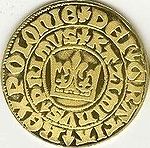 |
The base of the currency |
| półtorak | 1+1⁄2 grosza | Sigismund III Vasa | 1614-1660; in the John II Casimir Vasa and Augustus III reigns | Silver (46.9%) alloy | 1.09 g (Augustus III) |  |
Created as an intermediate between grosz and trojak |
| dwojak | 2 grosze | Sigismund II Augustus | Around the 1520s; sporadically later; more minted at John II Casimir Vasa's reign; 1766–1784; 1923–1939; 1954– | Sigismund I the Old: silver
Sigismund II Augustus: silver Stanislaus II: 58.7% silver alloy |
1.8 g (Sigismund I the Old)
ca. 3.5 g (Sigismund II Augustus); 3.4 g (Stanislaus II Augustus) |
||
| trojak | 3 grosze | Sigismund I the Old | 1528–1849 | Silver, most copper from Stanislaus II Augustus' reign;
some Gdańsk coins are copper |
2.16 g ("Kingdom" trojak)
1.53 g (Gdańsk trojak); 11.69 g (Stanislaus Augustus) 1.52 g (silver Gdańsk and Toruń trojak) |
 |
Also called "dutka", "babka", "dydek" in Lithuania |
| czworak | 4 grosze | Sigismund II Augustus | 1565–1568; 1614; 1766–1795 | Silver;
55% silver alloy (Stanislaus II Augustus) |
4.29 g;
5.51 g (Stanislaus II Augustus) |
||
| szóstak | 6 groszy | Sigismund I the Old | 1528–1795 | Silver | 2.34 g (Toruń szóstak)
2.94 g (Gdańsk and Elbląg szóstak); 3.7 g (Kurland szóstak) 4.32 g ("Kingdom" szóstak); in 1794–1795 1.52 g |
 |
|
| 2 złote [Stanislaus II and Augustus III] | 8 groszy | Augustus III | 1753-1795 | 62.67% silver alloy | 9.35 g (Stanislaus II)
7.31 g (Augustus III) |
||
| półurcie | 9 groszy | ? | ? | ? | ? | ||
| 10 copper Kingdom groszy | 10 groszy | Stanislaus II Augustus | 1787-95 | 37.3% silver alloy | 2.49 g, then 4.48 g | ||
| ort | 18 groszy | Sigismund III Vasa | 1608–1766 | Silver | Augustus III reign:
5.84 g ("Kingdom") 6.1 g or 7.7 g (Gdańsk) |
  |
Coins of 1618 were minted by Stanisław Berman |
| półkopek | 30 groszy;
Stanislaus II Augustus' złoty - 4 grosze |
Sigismund II Augustus | 1564–1841 | Silver alloy (49.955%) | 6.726 g (John III Sobieski)
5.84 g ("Kingdom") or 6.1 g (Gdańsk) tymf; złotówka gdańska: 9.85 g |
 |
From 1663 on also called tymf |
| kopa | 60 groszy = 2 złote | ? | ? | Silver | ? | ||
| półtalar | 15–120 groszy (de facto 15–290, more expensive as time passed) | Sigismund II Augustus | 1567–1794 | Silver | ca. 12.5 g;
14.62 g (Augustus III reign); 14.03 g, later 13.07 g (Stanislaus II Augustus) |
 |
|
| +2⁄3 of talar | only commemorative | Augustus III | 1738; 1747 | Silver | |||
| talar | 30–240 groszy (de facto 30–580, more expensive as time passed) | Sigismund I the Old | 1533; 1580–1795 | Silver;
83.3% silver alloy (from 1766) |
ca. 24.3–29.3 g |  |
|
| 2 talars | 480 groszy (de facto 1160 groszy) | Augustus III | 1740 | Silver | 58 g | ||
| dukat (florin) | 45–1,080 groszy | Ladislaus the Short | Early 14th century–1831 | Gold;
98.6% gold alloy (1766–95) |
3.46-3.5 g in the second half of the 18th century |    | |
| 2 ducats | Augustus III | 1753-4 | Gold | 7 g | |||
| 6 ducats | Augustus III | 1742 | Gold | 21 g | |||
| portugał | 10 ducats | Sigismund II Augustus | 1562–1652 | Gold | 35 g (Augustus III) |   | |
| 12 ducats | Augustus III | 1740 | Gold | 29.17 g | |||
| półaugustdor | 2+1⁄2 talars = 600 groszy (de jure); 1,450 groszy (de facto) | Augustus III of Poland | 1752–1756 | Gold | 3.32 g | ||
| augustdor | 5 talars = 1,200 groszy (de jure); 2,900 groszy (de facto) | Augustus III of Poland | 1752–1756 | Gold | 3.32 g | ||
| double augustdor | 10 talars = 2400 talars (de jure); 5800 groszy (de facto) | Augustus III of Poland | 1752–1756 | Gold | 13.3 g | ||
| semi-stanislasdor (półstanislasdor) | 27 złotych | Stanislaus II Augustus | 1794–1795 | Gold | 6.17 g | ||
| stanislasdor | 54 złotych | Stanislaus II Augustus | 1794–1795 | Gold (83%) | 12.35 g |
| Picture | Denomination | Size | Colour | Obverse | Reverse | Watermark | Date of print | Date of withdrawal |
|---|---|---|---|---|---|---|---|---|

|
1 złoty | 93×63 | Yellow | Tadeusz Kościuszko, denomination in words, date of print | Coat of arms, denomination in number | — | 28 February 1919 | 31 January 1940 |

|
2 złote | 115×80 | Blue | Denomination in number | — | |||

|
5 złotych | 125×80 | Bright yellow,
orange |
Józef Poniatowski, denomination in words, date of print | Denomination in words, coat of arms | — | 28 February 1919
15 July 1924 | |
| 10 złotych | 150×88 | Yellow | Tadeusz Kościuszko, denomination in words, date of print | Some agricultural products[dubious – discuss] | As portrait | 28 February 1919 (not released in public) | ||
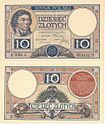
|
Pink | 28 February 1919, 15 July 1924 | ||||||
| 20 złotych | 160×97 | White, red around the coat of arms and watermark | Denomination in numbers, coat of arms | |||||

|
50 złotych | 165×102 | Brown, yellow around denomination in words | 28 February 1919 | ||||
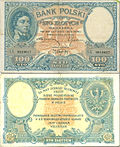
|
100 złotych | 172×103 | Blue | |||||

|
500 złotych | 180×110 | Violet and olive | |||||
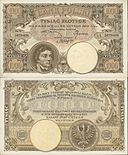
|
1000 złotych | 183×111 | Brown | 28 February 1919 (extremely rare, not released in public) | ||||

|
5000 złotych | 190×113 | Different shades of green | 28 February 1919 (not released in public) | ||||
| These images are to scale at 0.7 pixel per millimetre. For table standards, see the banknote specification table. | ||||||||
| Pictures | Denomination | Diameter(mm) | Thickness(mm) | Mass(g) | Composition | Obverse | Reverse | Introduced | Issued | Withdrawn |
|---|---|---|---|---|---|---|---|---|---|---|
 |
1 grosz | 14.7 | 1.01 | 1.5 | bronze | Polish coat of arms' eagle, inscription: "Rzeczpospolita Polska" and the year of minting | denomination with a simple plant ornament | 1923 | 1923; 1925 1927
1928 1930-1939 |
1939 |
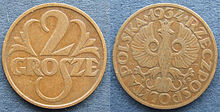 |
2 grosze | 17.6 | 0.96 | 2 | brass | Polish coat of arms' eagle, inscription: "Rzeczpospolita Polska" and the year of minting | denomination with a simple plant ornament | 1923 | 1923 | 1939 |
| 2 grosze | 17.6 | 0.98 | 2 | bronze | Polish coat of arms' eagle, inscription: "Rzeczpospolita Polska" and the year of minting | denomination with a simple plant ornament | 1923 | 1925 1927 1928
1930-1939 |
1939 | |

|
5 groszy | 20 | 1.12 | 3 | brass | Polish coat of arms' eagle, inscription: "Rzeczpospolita Polska" and the year of minting | denomination with a simple plant ornament | 1923 | 1923 | 1939 |
| 5 groszy | 20 | 1.14 | 3 | bronze | Polish coat of arms' eagle, inscription: "Rzeczpospolita Polska" and the year of minting | denomination with a simple plant ornament | 1923 | 1925 1928 1930
1931 1934-1939 |
1939 | |
 
|
10 groszy | 17.6 | 0.92 | 2 | nickel | Polish coat of arms' eagle, inscription: "Rzeczpospolita Polska" and the year of minting | denomination with a complicated bush ornament | 1923 | 1923 | 1939 |
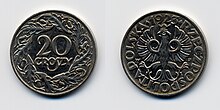
|
20 groszy | 20 | 1.07 | 3 | nickel | Polish coat of arms' eagle, inscription: "Rzeczpospolita Polska" and the year of minting | denomination with a complicated bush ornament | 1923 | 1923 | 1939 |

|
50 groszy | 23 | 1.35 | 5 | nickel | Polish coat of arms' eagle, inscription: "Rzeczpospolita Polska" and the year of minting | denomination with a complicated bush ornament | 1923 | 1923 | 1939 |

|
1 złoty | 25 | 1.6 | 7 | nickel | Polish coat of arms' eagle, inscription: "Rzeczpospolita Polska" and the year of minting | denomination with an ornament | 1929 | 1929 | 1939 |
| Pictures | Denomination | Dimension(mm) | Colour | Obverse | Reverse | Watermark | Date of introduction | Date of printing | Date of withdrawal | Author |
|---|---|---|---|---|---|---|---|---|---|---|
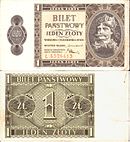 |
1 złoty | 108×60 | brown | Bolesław I the Brave, denomination, the "Bank of Poland" and "Government note" inscriptions, date and place of issue | Denomination | As portrait | 1 October 1938 | 20 May 1940 | Leonard | |
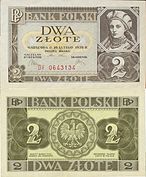 |
2 złote | 102×63 | Gray-yellow | Denomination, portrait of a Doubravka of Bohemia, the "Bank of Poland" inscription, date and place of issue | Denomination, Polish coat of arms | Value(2 zł) | 26 February 1936 | Zdzisław Eichler | ||
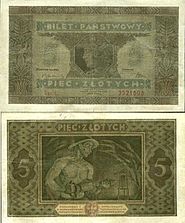
|
5 złotych | 127×83 | Olive, yellow edges | Portrait of a man[who?], denomination, place and date of issue | A miner in the tunnel, denomination | - | 1 May 1925 | 1 May 1925, 25 October 1926 | Wacław Borowski | |
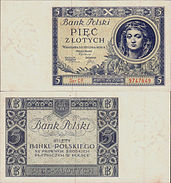 |
144×78 | Blue | Denomination, portrait of a woman[who?], the "Bank of Poland" inscription, date and place of issue | Denomination, coat of arms, "Bank of Poland" inscription | Sigismund I the Old | 2 January 1930 | 2 January 1930 or 26 February 1936 | Ryszard Kleczewski | ||
 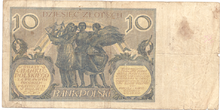
|
10 złotych | 160×80 | Light brown | Denomination, pictures of saints, coat of arms, the "Bank of Poland" inscription, date and place of issue | A woman with a model ship in her hands, a worker and a female peasant with a bunch of wheat | Bolesław I the Brave, 10 ZŁ | 20 July 1926 | 20 July 1926, 20 July 1929 | Zdzisław Eichler | |

|
158×80 | Green | Denomination, a picture of a woman[who?], the "Bank of Poland" inscription, date and place of issue | A road in the field that passes between the trees | As portrait | Never introduced | 2 January 1928 | ? | ||

|
20 złotych | 170×94 | Obverse: brown, turquoise edges of picture; reverse: violet | A female peasant with a bunch of wheat and a male with a spade, denomination, "Bank of Poland" inscription, date and place of issue | Bank of Poland buildings: the one at the left is the former bank building on the Plac Bankowy; the newer one on the Bielańska street. | Casimir III the Great, 20 ZŁ | 1 March 1926 | 1 March 1926, 20 June 1931 | Zygmunt Kamiński | |

|
163×86 | Violet | Portrait of a young girl, denomination, coat of arms, the "Bank of Poland" inscription, date and place of issue | Morskie Oko lake | As portrait | Never introduced | 2 January 1928 | ? | ||
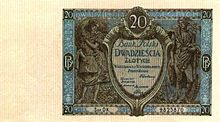
|
170×94 | Obverse: brown, light blue edges of picture; reverse: blue | Fortuna with a bunch of wheat and Hermes with a spade, denomination, "Bank of Poland" inscription, date and place of issue | Bank of Poland buildings: the one at the left is the former bank building on the Plac Bankowy; the newer one on the Bielańska street. | Casimir III the Great, 20 ZŁ | 1 September 1929 | Zygmunt Kamiński | |||
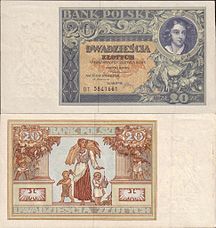
|
163×86 | Blue obverse, light green reverse | Portrait of Emilia Plater, denomination, the "Bank of Poland" inscription, date and place of issue | A female peasant with a bunch of wheat and two boys, one of which holding a ship, other a hammer, coat of arms and denomination | Casimir III the Great, 20 ZŁ | 20 June 1931 | Ryszard Kleczewski | |||
 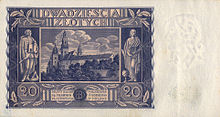
|
Grey and blue | Emilia Plater, a woman with two daughters on the left with flowers, coat of arms, the "Bank of Poland" inscription, date and place of issue | Wawel Castle, Kraków, a figure of an architect and a poet (symbolize knowledge) | As portrait and denomination | 11 November 1936 | Wacław Borowski | ||||

|
50 złotych | 188×99 | green, blue and brown | Fortuna with a bunch of wheat and Hermes with a rod of Asclepius, denomination, "Bank of Poland" inscription, date and place of issue | Bank of Poland buildings: the one at the left is the former bank building on the Plac Bankowy; the newer one on the Bielańska street. | Stefan Batory, 50 złotych | 28 August 1925 | 28 August 1925, 1 September 1929, | Zygmunt Kamiński | |

|
169×92 | green | Jan Henryk Dąbrowski portrait, coat of arms, the "Bank of Poland" inscription, date and place of issue | A peasant with a bunch of wheat, two women holding a ship, a boy with an airplane and a worker with a hammer | As portrait and denomination | Never introduced | 11 November 1936 | Wacław Borowski | ||
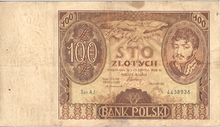 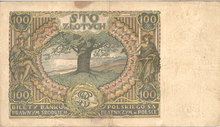 |
100 złotych | 175×98 | Brown | Józef Poniatowski's portrait, denomination, the "Bank of Poland" inscription, date and place of issue | A picture of an oak representing the history of Poland | Queen Jadwiga, 100 ZŁ | 2 June 1932 | 2 June 1932, 9 November 1934 | Józef Mehoffer | |
| These images are to scale at 0.7 pixel per millimetre. For table standards, see the banknote specification table. | ||||||||||
| Pictures | Denomination | Size (mm) | Colour | Obverse | Reverse | Watermark | Date of print | Designer |
|---|---|---|---|---|---|---|---|---|
 |
1 złoty | 72×45 | Bright red | Denomination, the "Bank of Poland" inscription, date and place of issue | Denomination | None | 15 August 1939 | Włodzimierz Vacek |
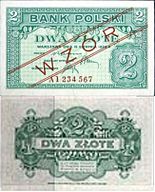
|
2 złote | 82×51 | Bright green | Denomination, the "Bank of Poland" inscription, date and place of issue | Denomination, ornament[which?] | |||
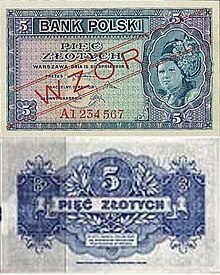
|
5 złotych | 97×60 | Blue to cyan | Denomination, portrait of a woman in the traditional costume, the "Bank of Poland" inscription, date and place of issue | Denomination | |||

|
10 złotych | 141×67 | Red | Denomination, a picture of a woman with a necklace, the "Bank of Poland" inscription, date and place of issue | Płock Cathedral | As portrait | Edouard Meronti | |

|
20 złotych | 153×75 | Grey to blue | Denomination, a picture of a female Silesian with a cross, the "Bank of Poland" inscription, date and place of issue | A power plant, behind the typically rural landscape, with haystacks | Edmund Dulac | ||

|
Obverse: different shades of blue, reverse: grey | Denomination, a picture of a girl in the traditional costume, the "Bank of Poland" inscription, date and place of issue | Saintmost Trinity Church in Leszczyny (now in Palowice) | - | 20 August 1939 | ? | ||

|
50 złotych | 163×80 | cyan | A mountain peasant (góral), mountain flowers motive, denomination, | Morskie Oko lake, coat of arms | As portrait and denomination | 15 August 1939 | Clément Serveau |
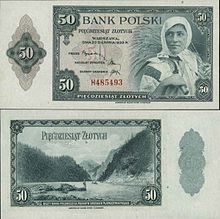
|
50 złotych | A female peasant with a sickle and a bunch of cereals | Dunajec River Gorge | - | 20 August 1939 | ? | ||
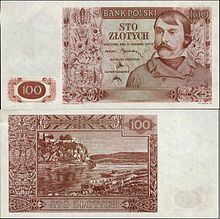
|
100 złotych | 171×86 | Brown | A portrait of a Mazury peasant, denomination, the "Bank of Poland" inscription, date and place of issue | Landscape nearby the Tyniec, near Kraków | Portrait of a female on 50 zł (20 August 1939) | 15 August 1939 | Clément Serveau |
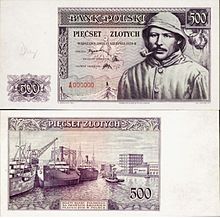
|
500 złotych | 182×89 | Grey | A portrait of a fisherman with a pipe, denomination, the "Bank of Poland" inscription, date and place of issue | Port in Gdynia | Edouard Meronti | ||
| These images are to scale at 0.7 pixel per millimetre. For table standards, see the banknote specification table. | ||||||||
| Obverse | Reverse | Denomination | Size(mm) | Colour | Obverse | Reverse | Date of issue | Date of release | Amount
printed |
Date of withdrawal |
|---|---|---|---|---|---|---|---|---|---|---|
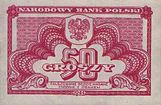 |
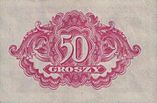 |
50 groszy | 81×52 | Bright pink | Denomination
"The National Bank of Poland" inscription, date, coat of arms |
Denomination | 1944 | 28 February 1945 | 6,706,000
(3,503,000 zł) |
8 November 1950 |
 |

|
1 złoty | 136×66 | Green | Denomination,
"The National Bank of Poland" inscription |
18 September 1944 | 47,726,000 (47,726,000 zł) | |||

|

|
2 złote | 137×67 | Red | 18,725,000
(37,450,000 zł) | |||||

|

|
5 złotych | 142×71 | Brown | 81,183,000
(405,915,000 zł) | |||||
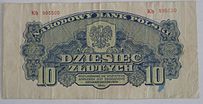
|
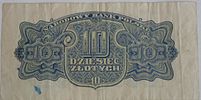
|
10 złotych | 160×80 | Blue | 27 August 1944 | 22,005,000
(220,050,000 zł) | ||||
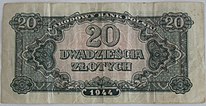
|
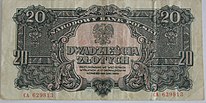
|
20 złotych | 170×83 | Teal | 114,687,000
(2,293,740,000 zł) | |||||
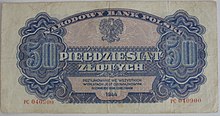
|

|
50 złotych | 180×93 | Blue-violet | 26,342,000
(1,317,100,000 zł) | |||||
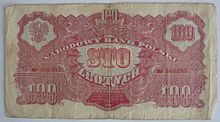
|
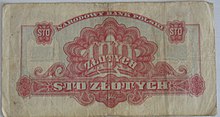
|
100 złotych | 188×100 | Pink | 71,237,000
(7,123,700,000 zł) | |||||

|
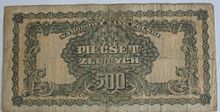
|
500 złotych | 193×102 | Olive | 19,787,000
(9,893,500,000 zł) |
17 December 1946 | ||||

|

|
1000 złotych
(by Ryszard Kleczewski) |
182×97 | Brown | 1945 | 1 September 1945 | ca. 19,000,000
(19,000,000,000 zł) |
8 November 1950 | ||
| These images are to scale at 0.7 pixel per millimetre. For table standards, see the banknote specification table. | ||||||||||
| Pictures | Denomination | Size(mm) | Colour | Obverse | Reverse | Date of print | Date of release | Date of withdrawal | |
|---|---|---|---|---|---|---|---|---|---|

|

|
1 złoty | 98×54 | Red | Denomination, "The National Bank of Poland" inscription, date | Denomination | 15 May 1946 | 2 December 1946 | 8 November 1950 |
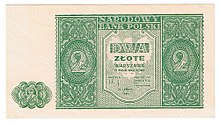
|
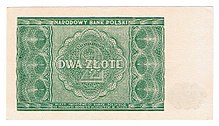
|
2 złote | 104×57 | Green | 15 March 1947 | ||||

|
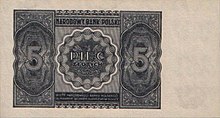
|
5 złotych | 122×66 | Grey-blue | 5 February 1948 | ||||

|

|
10 złotych | 128×70 | Brown, red | Denomination, "The National Bank of Poland" inscription, date, coat of arms | Denomination, "The National Bank of Poland" inscription | 18 August 1947 | ||
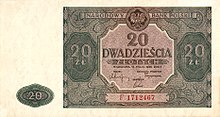
|

|
20 złotych | 158×84 | Blue to red | Two planes; denomination | 1 July 1948 | |||
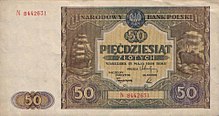
|

|
50 złotych | 164×87 | Brown, violet | Denomination, "The National Bank of Poland" inscription, date, coat of arms; a steam boat and a sail boat | Boats on the sea, anchors; denomination | 22 September 1947 | ||
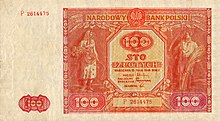
|
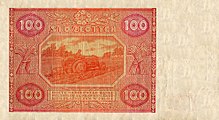
|
100 złotych | 170×91 | Red, brown | Denomination, "The National Bank of Poland" inscription, date, coat of arms; a female peasant with a bunch of cereals, a male peasant with a bunch of wheat and a sickle | A peasant on a tractor in the field | 2 December 1946 | ||
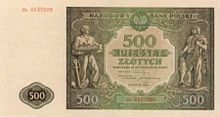
|
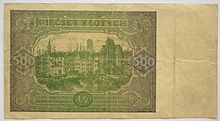
|
500 złotych | 176×94 | Green to blue | Denomination, "The National Bank of Poland" inscription, date, coat of arms; a sailor with an anchor and a model of ship; a fisherman | The Old City in Gdańsk | 15 January 1946 | 15 July 1946 | |
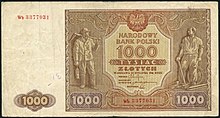
|

|
1000 złotych | 182×97 | Brown | Denomination, "The National Bank of Poland" inscription, date, coat of arms; miners | Łódź factories panorama | ? | ||
| These images are to scale at 0.7 pixel per millimetre. For table standards, see the banknote specification table. | |||||||||
| Pictures | Denomination | Size(mm) | Colour | Obverse | Reverse | Date of print | Date of release | Date of withdrawal | |
|---|---|---|---|---|---|---|---|---|---|
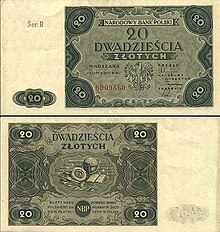
|
20 złotych | 158×84 | Dark green | Denomination, "The National Bank of Poland" inscription, date, coat of arms | A globe, a book, a machinery detail, a hammer and ralis, symbolising education and industrial work | 15 July 1947 | 16 June 1949 | 8 November 1950 | |
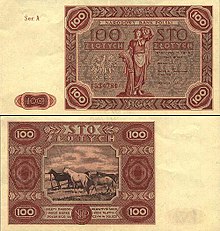
|
100 złotych | 170×91 | Brown-red | Denomination, "The National Bank of Poland" inscription, date, coat of arms; a female peasant | Horses in a field | 21 February 1949 | |||
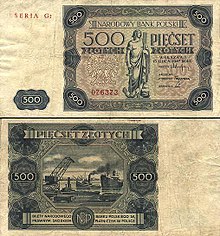
|
500 złotych | 176×94 | Blue | Denomination, "The National Bank of Poland" inscription, date, coat of arms; a female sailor with an anchor | Gdynia port | 1 July 1947 | 20 January 1949 | ||
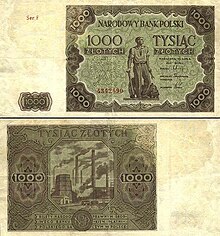
|
1000 złotych | 182×97 | Olive, brown | Denomination, "The National Bank of Poland" inscription, date, coat of arms; a miner with a hammer | A picture of a factory | 1 December 1948 | |||
| These images are to scale at 0.7 pixel per millimetre. For table standards, see the banknote specification table. | |||||||||
| Pictures | Denomination | Size(mm) | Colour | Obverse | Reverse | Date of print | Date of release | Date of withdrawal | |
|---|---|---|---|---|---|---|---|---|---|

|

|
2 złote | 120×58 | Pale green | Denomination, "The National Bank of Poland" inscription, date, coat of arms (without the crown) | Buildings | 1 July 1948 | 30 October 1950 | 30 September 1960 |

|

|
5 złotych | 142×67 | Brown | A peasant on a tractor in a field | 31 December 1959 | |||

|

|
10 złotych | 148×70 | Olive-brown | Denomination, "The National Bank of Poland" inscription, date, coat of arms (without the crown); portrait of a peasant | Peasants at harvesting cereals | 31 December 1965 | ||

|

|
20 złotych | 160×76 | Blue | Denomination, "The National Bank of Poland" inscription, date, coat of arms (without the crown); portrait of a woman | Cloth Hall, Kraków | 30 June 1977 | ||

|

|
50 złotych | 164×78 | Green to olive | Denomination, "The National Bank of Poland" inscription, date, coat of arms (without the crown); portrait of a fisherman | Gdynia port | 30 June 1978 | ||

|

|
100 złotych | 172×82 | Red | Denomination, "The National Bank of Poland" inscription, date, coat of arms (without the crown); portrait of a miner | A picture of a factory | 30 June 1977 | ||

|

|
500 złotych | 178×85 | Black-brown | Denomination, "The National Bank of Poland" inscription, date, coat of arms (without the crown); portrait of a miner | A picture of coal mining | 31 December 1977 | ||
| 1000 złotych | 150×74 | Bright yellow, red, brown and grey | Denomination, "The National Bank of Poland" inscription, date, coat of arms (without the crown); Mikołaj Kopernik | Nicolaus Copernicus's heliocentric model of the Solar System | 29 October 1965 | 1 June 1966 | 31 December 1978 | ||
| These images are to scale at 0.7 pixel per millimetre. For table standards, see the banknote specification table. | |||||||||
Diameter (⌀) shown in mm, mass in grams. 1 - Minted both in Budapest and Warsaw in numbers of 300,100,600 coins.
| Pictures | Denomination | Ø | Mass | Metal | Edge | Obverse | Reverse | Issued in Budapest | Issued in Warsaw | Issued in Basel | Issued in Kremnica | Issued in Leningrad | Introduced | Issued | Withdrawn | With inscription "... Ludowa"? |
|---|---|---|---|---|---|---|---|---|---|---|---|---|---|---|---|---|

|
1 grosz | 14.7 | 0.5 | aluminium | rifled | Coat of arms, year of minting | Denomination, leaf ornament | 400,000,000 | 116,000 | 1954 | 1949 | 1 January 1995 | No | |||

|
2 grosze1 | 16 | 0.57 | aluminium | rifled | Coat of arms, year of minting | Denomination, leaf ornament | 1954 | 1949 | 1 January 1995 | No | |||||

|
5 groszy | 20 | 3 | bronze | smooth | Coat of arms, year of minting | Denomination, leaf ornament | 300,000,000 | 1950 | 1949 | 1956 | No | ||||

|
5 groszy | 20 | 1 | aluminium | rifled | Coat of arms, year of minting | Denomination, leaf ornament | 200,000,000 | 1960 | 1949 | 1 January 1995 | No | ||||
| 5 groszy | 16 | 0.6 | aluminium | smooth | Coat of arms, year of minting | Denomination, leaf ornament | 310,364,378 | 1958 | 1958-63; 1965; 1967–1968; 1970–1972 | 1 January 1995 | Yes | |||||

|
10 groszy | 17.6 | 2 | cupronickel | smooth | Coat of arms, year of minting | Denomination, branch ornament | 200,000,000 | 1950 | 1949 | 1 January 1995 | No | ||||

|
10 groszy | 17.6 | 0,7 | aluminium | smooth | Coat of arms, year of minting | Denomination, branch ornament | 31,046,685 | 1950 | 1949 | 1 January 1995 | No | ||||
| 10 groszy | 17.6 | 0,7 | aluminium | smooth | Coat of arms, year of minting | Denomination, branch ornament | 1,179,713,719 | 100,000,000 | 1961 | 1961-3; 1965–1981; 1983; 1985 | 1 January 1995 | Yes | ||||

|
20 groszy | 20 | 3 | cupronickel | smooth | Coat of arms, year of minting | Denomination, branch ornament | 133,383,000 | 1950 | 1949 | 1 January 1995 | No | ||||

|
20 groszy | 20 | 1 | aluminium | smooth | Coat of arms, year of minting | Denomination, branch ornament | 197,491,750 | 1950 | 1949 | 1 January 1995 | No | ||||
| 20 groszy | 20 | 1 | aluminium | smooth | Coat of arms, year of minting | Denomination, branch ornament | 879,964,867 | 50,000,000 | 1957 | 1957; 1961–1963; 1965–1973; 1975–1978; 1980–1981; 1983; 1985 | 1 January 1995 | Yes | ||||

|
50 groszy | 23 | 5 | cupronickel | rifled | Coat of arms, year of minting | Denomination, branch ornament | 109,000,000 | 1950 | 1949 | 1 January 1995 | No | ||||

|
50 groszy | 23 | 1.6 | aluminium | rifled | Coat of arms, year of minting | Denomination, branch ornament | 59,392,950 | 1950 | 1949 | 1 January 1995 | No | ||||
| 50 groszy | 23 | 1.6 | aluminium | rifled | Coat of arms, year of minting | Denomination, branch ornament | 376,793,589 | 66,800,000 | 1957 | 1957; 1965; 1967–1968; 1970–1978; 1982–1985 | 1 January 1995 | Yes | ||||
| 50 groszy | 23 | 1.6 | aluminium | rifled | Coat of arms, year of minting | Denomination, branch ornament | 49,052,000 | 1986 | 1986-7 | 1 January 1995 | Yes | |||||

|
1 złoty | 25 | 7 | cupronickel | rifled | Coat of arms, year of minting | Denomination, branch ornament | 87,053,000 | 1950 | 1949 | 1 January 1995 | No | ||||

|
1 złoty | 25 | 2.12 | aluminium | rifled | Coat of arms, year of minting | Denomination, branch ornament | 43,000,000 | 1950 | 1949 | 1 January 1995 | No | ||||
| 1 złoty | 25 | 2.12 | aluminium | rifled | Coat of arms, year of minting | Denomination, branch ornament | 1,110,555,639 | 60,000,106 | 1957 | 1957, 1965–1978, 1980–1988 | 1 January 1995 | Yes | ||||
| 1 złoty | 16 | 0.57 | aluminium | rifled | Coat of arms, year of minting | Denomination, branch ornament | 1989 | 1989-90 | 1 January 1995 | Yes | ||||||
| 2 złote | 27 | 2.7 | aluminium | rifled | Coat of arms, year of minting | Denomination, branch and cereal ornament | 189,955,432 | 1958 | 1958-60; 1970–1974 | 1 January 1995 | Yes | |||||
| 2 złote | 21 | 3 | brass | rifled | Coat of arms, year of minting | Denomination, branch and cereal ornament | 633,950,957 | 137,600,000 | 1975 | 1975-1988 | 1 January 1995 | Yes | ||||
| 2 złote | 18 | 0.7 | aluminium | rifled | Coat of arms, year of minting | Denomination, branch and cereal ornament | 132,217,000 | 1989 | 1989-90 | 1 January 1995 | Yes | |||||
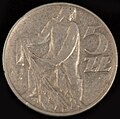
|
5 złotych | 29 | 3.45 | aluminium | rifled | Coat of arms, year of minting | Denomination, fisher | 126,439,614 | 1958 | 1958-60; 1971; 1973–1974 | 1 January 1995 | Yes | ||||
| 5 złotych | 24 | 5 | brass | rifled | Coat of arms, year of minting | Denomination | 315,831,723 | 135,000,000 | 1975 | 1975-88 | 1 January 1995 | Yes | ||||
| 5 złotych | 20 | 0.88 | aluminium | rifled | Coat of arms, year of minting | Denomination | 68,501,000 | 1989 | 1989-90 | 1 January 1995 | Yes | |||||
| 10 złotych | 31 | 12.9 | cupronickel | rifled | Coat of arms, year of minting | Denomination; Nicolaus Copernicus | 15,558,855 | 1959 | 1959; 1965 | 1 January 1995 | Yes | |||||
| 10 złotych | 28 | 9.5 | cupronickel | rifled | Coat of arms, year of minting | Denomination; Nicolaus Copernicus | 20,129,000 | 1967 | 1967-9 | 1 January 1995 | Yes | |||||
| Analogical to the one lower | 10 złotych | 31 | 12.9 | cupronickel | rifled | Coat of arms, year of minting | Denomination; Tadeusz Kościuszko | 44,808,153 | 1959 | 1959-60; 1966 | 1 January 1995 | Yes | ||||
| 10 złotych | 28 | 9.5 | cupronickel | rifled | Coat of arms, year of minting | Denomination; Tadeusz Kościuszko | 45,111,000 | 1969 | 1969-73 | 1 January 1995 | Yes | |||||
| 10 złotych | 25 | 7.7 | cupronickel | rifled | Coat of arms, year of minting | Denomination, Bolesław Prus | 136,314,606 | 1975 | 1975-8;
1981-4 |
1 January 1995 | Yes | |||||
| 10 złotych | 25 | 7.7 | cupronickel | rifled | Coat of arms, year of minting | Denomination, | >55,000,000 | 1975 | 1975-7 | 1 January 1995 | Yes | |||||
| 10 złotych | 25 | 7.7 | cupronickel | rifled | Coat of arms, year of minting | Denomination | 224,209,255 | 1984 | 1984-8 | 1 January 1995 | Yes | |||||
| 10 złotych | 22 | 4.27 | manganese brass | rifled | Coat of arms, year of minting | Denomination | 187,692,000 | 1989 | 1989-90 | 1 January 1995 | Yes | |||||
| 20 złotych | 29 | 10.15 | cupronickel | rifled | Coat of arms, year of minting | Denomination; a skyscraper and cereals | 20,000,000 | 37,000,000 | 1973 | 1973-4; 1976 | 1 January 1995 | Yes | ||||
| 20 złotych | 29 | 10.15 | cupronickel | rifled | Coat of arms, year of minting | Denomination; Marceli Nowotko | 56,152,000 | 30,000,000 | 1974 | 1974-7; 1983 | 1 January 1995 | Yes | ||||
| 20 złotych | 26.5 | 8.7 | cupronickel | rifled | Coat of arms, year of minting | Denomination | 103,383,710 | 1984 | 1984-8 | 1 January 1995 | Yes | |||||
| 20 złotych | 24 | 5.65 | cupronickel | rifled | Coat of arms, year of minting | Denomination | 200,686,000 | 1989 | 1989-90 | 1 January 1995 | Yes |
| Pictures | Denomination | Size(mm) | Colour | Obverse | Reverse | Dates of print | Date of introduction | Date of withdrawal | Date of lapse |
|---|---|---|---|---|---|---|---|---|---|
 
|
10 złotych | 139×63 | Blue to green | Denomination, "The National Bank of Poland" inscription, date, coat of arms (without the crown); Józef Bem | Denomination | 1 June 1982 | 11 June 1982 | 31 December 1994 | 31 December 2010 |
| 20 złotych | Mainly red to blue | Denomination, "The National Bank of Poland" inscription, date, coat of arms (without the crown); Romuald Traugutt | Denomination | 1 June 1982 | 11 June 1982 | ||||
| 50 złotych | Green | Denomination, "The National Bank of Poland" inscription, date, coat of arms (without the crown); Karol Świerczewski | Order of the Cross of Grunwald | 9 May 1975; 1 June 1979; 1 June 1982; 1 June 1986; 1 December 1988 | 25 November 1975 | ||||
| 100 złotych | Red | Denomination, "The National Bank of Poland" inscription, date, coat of arms (without the crown); Ludwik Waryński | "Proletaryat" | 15 January 1975; 17 May 1976; 1 June 1979; 1 June 1982; 1 June 1986; 1 December 1988 | 1 July 1975 | 31 December 1996 | |||
| 200 złotych | Violet | Denomination, "The National Bank of Poland" inscription, date, coat of arms (without the crown); Jarosław Dąbrowski | Communards' Wall; "Za waszą wolność i naszą" (For our liberty and yours). | 25 May 1976;
1 June 1979; 1 June 1982; 1 June 1986; 1 December 1988 |
26 July 1976 | ||||
| 500 złotych | Brown | Denomination, "The National Bank of Poland" inscription, date, coat of arms (without the crown); Tadeusz Kościuszko | The insurrection flag | 16 December 1974; 15 June 1976; 1 June 1979; 1 June 1982 | 1 January 1975 | ||||
| 1,000 złotych | Blue | Denomination, "The National Bank of Poland" inscription, date, coat of arms (without the crown); Mikołaj Kopernik | Nicolaus Copernicus's heliocentric model of the Solar System | 2 July 1975; 1 June 1979; 1 June 1982 | 1 September 1975 | ||||
| 2,000 złotych | Dark brown | Denomination, "The National Bank of Poland" inscription, date, coat of arms (without the crown); Mieszko I | Bolesław I the Brave with a sword | 1 May 1977; 1 June 1979; 1 June 1982 | 27 July 1977 | ||||
| 5,000 złotych | Green | Denomination, "The National Bank of Poland" inscription, date, coat of arms (without the crown); Fryderyk Chopin | Polonaise in notes (author: Fryderyk Chopin) | 1 June 1982; 1 June 1986; 1 December 1988 | 11 June 1982 | ||||
| 10,000 złotych | Green and violet | Denomination, "The National Bank of Poland" inscription, date, coat of arms (without the crown); Stanisław Wyspiański | Kraków (Planty) | 1 February 1987; 1 December 1988 | 4 February 1987 | ||||
| 20,000 złotych | Orange | Denomination, "The National Bank of Poland" inscription, date, coat of arms (without the crown); Marie Curie | Ewa reactor | 1 February 1989 | 26 February 1989 | ||||
| 50,000 złotych | Brown | Denomination, "The National Bank of Poland" inscription, date, coat of arms (without the crown); Stanisław Staszic | Staszic Palace in Warsaw | 1 December 1989 | 11 December 1989 | 15 October 1994 | |||
| 16 November 1993 | 11 April 1994 | 31 December 1996 | |||||||
| 100,000 złotych | Blue | Denomination, "The National Bank of Poland" inscription, date, coat of arms (with the crown); Stanisław Moniuszko | The Grand Theatre in Warsaw | 15 February 1990 | 26 February 1990 | 15 October 1994 | |||
| 16 November 1993 | 11 April 1994 | 31 December 1996 | |||||||
| 200,000 złotych | Brown | Denomination, date, coat of arms (without the crown) | Warsaw, coat of arms of Warsaw, the "National Bank of Poland" inscription | 1 December 1989 | 7 December 1989 | 17 May 1991 | |||
| 500,000 złotych | Cyan and brown | Denomination, "The National Bank of Poland" inscription, date, coat of arms (with the crown); Henryk Sienkiewicz | "The Trilogy", flags | 15 April 1990 | 1 August 1990 | 15 October 1994 | |||
| 16 November 1993 | 24 January 1994 | 31 December 1996 | |||||||
| 1,000,000 złotych | Light brown | Denomination, "The National Bank of Poland" inscription, date, coat of arms (with the crown); Władysław Reymont | A rural landscape | 15 February 1991 | 22 April 1991 | 15 October 1994 | |||
| 16 November 1993 | 24 January 1994 | 31 December 1996 | |||||||
| 2,000,000 złotych | Multi-coloured | Denomination, "The National Bank of Poland" inscription, date, coat of arms (with the crown); Ignacy Jan Paderewski | Coat of arms as of 1919 | 14 August 1992 | 10 November 1992 | 15 October 1994 | |||
| 16 November 1993 | 11 April 1994 | 31 December 1996 | |||||||
| 5,000,000 złotych | Gray and yellow | Denomination, "The National Bank of Poland" inscription, date, coat of arms (with the crown); Józef Piłsudski | Józef Piłsudski's orders | 12 May 1995 | 24 April 2006 (only as collection banknote) | Never withdrawn | Never lapsed | ||
| These images are to scale at 0.7 pixel per millimetre. For table standards, see the banknote specification table. | |||||||||
| Obverse | Reverse | Denomination | Size(mm) | Colour | Obverse | Reverse | Date of print |
|---|---|---|---|---|---|---|---|
| 1 złoty | 138×63 | blue | Gdynia Shipyard | "Dar Pomorza" yacht | 1 March 1990 | ||
| 2 złote | dark red to brown | A mining tower in Katowice | The Silesian Uprising monument, by Gustaw Zemła | ||||
| 5 złotych | dark green | City hall in Zamość | The Grunwald Cross Medal | ||||
| 10 złotych | dark red | Royal Castle in Warsaw | Mermaid of Warsaw | ||||
| 20 złotych | yellow | Żuraw Gate in Gdańsk (seen from the Motława) | Neptune's statue on the Neptune's fountain | ||||
| 50 złotych | violet | Town hall in Wrocław | Picture of the 16th-century seal of the city magistrate in Wrocław | ||||
| 100 złotych | orange | Town hall in Poznań | Picture of the old seal of the city magistrate in Poznań | ||||
| 200 złotych | light blue | Wawel Castle | Picture of the Piast dynasty seal | ||||
| 500 złotych | teal | Gniezno Cathedral | Picture of the seal of Gniezno in Piast dynasty times | ||||
| 1,000 złotych | multicoloured -
mainly yellow |
Kalisz | Picture of the seal of Kalisz city authorities | ||||
| 2,000 złotych | brown | Biskupin archaeological site - fortress | Dishes from the site | ||||
| These images are to scale at 0.7 pixel per millimetre. For table standards, see the banknote specification table. | |||||||
| Obverse picture | Reverse picture | Value | Dimensions | Colour | Watermark | Obverse | Reverse | Symbol | printing | issue | annul |
|---|---|---|---|---|---|---|---|---|---|---|---|
| 10 zł | 120 × 60 mm | Green and brown | As portrait | Mieszko I | Silver denar coin during the reign of Mieszko I | Square | 25 March 1994 | 1 January 1995 | current | ||
| 20 zł | 126 × 63 mm | Pink, violet and blue | Bolesław I the Brave | Silver denar coin during the reign of Bolesław I the Brave; St. Nicholas Church in Cieszyn | Circle | ||||||
| 50 zł | 132 × 66 mm | Mainly blue | Casimir III the Great | White Eagle from the royal seal of Casimir III the Great and the regalia of Poland: sceptre and globus cruciger;
Kraków drawing from a medieval book |
Rhombus | ||||||
| 100 zł | 138 × 69 mm | Mainly green | Władysław II Jagiełło | Shield bearing a White Eagle from the tombstone of Władysław II Jagiełło, coat of the Teutonic Knights and the Grunwald Swords; Malbork castle on the left | Plus | 1 June 1995 | |||||
| 200 zł | 144 × 72 mm | Mainly yellow | Sigismund I the Old | Eagle intertwined with the letter S in a hexagon, from the Sigismund's Chapel in Kraków | Triangle | ||||||
| These images are to scale at 0.7 pixel per millimetre. For table standards, see the banknote specification table. | |||||||||||
| Obverse pictures | Reverse pictures | Denomination | Diameter(mm) | Mass(g) | Composition | Edge | Obverse | Reverse | Issued | Producer |
|---|---|---|---|---|---|---|---|---|---|---|
| 1 grosz | 15.5 | 1.64 | manganese brass | rifled | denomination with a leaf ornament | Polish coat of arms', inscription: "Rzeczpospolita Polska" and the year of minting | 1990-3
1995 1997-2005 2007-14 |
Mennica Warszawska | ||
| steel galvanized by brass | Polish coat of arms', inscription: "Rzeczpospolita Polska" and the year of minting (design different from the one of earlier issues) | 2013-6 | The Royal Mint | |||||||
| 2 grosze | 17.5 | 2.13 | manganese brass | smooth | denomination with a leaf ornament | Polish coat of arms', inscription: "Rzeczpospolita Polska" and the year of minting | 1990-2
1997-2005 2007-14 |
Mennica Warszawska | ||
| steel galvanized by brass | Polish coat of arms', inscription: "Rzeczpospolita Polska" and the year of minting (design different from the one of earlier issues) | 2013-6 | The Royal Mint | |||||||
| 5 groszy | 19.5 | 2.59 | manganese brass | milled: 4 rows, each has 12 dents | denomination with a leaf ornament | Polish coat of arms', inscription: "Rzeczpospolita Polska" and the year of minting | 1990-3
1998-2005 2007-14 |
Mennica Warszawska | ||
| steel galvanized by brass | Polish coat of arms', inscription: "Rzeczpospolita Polska" and the year of minting (design different from the one of earlier issues) | 2013-6 | The Royal Mint | |||||||
| 10 groszy | 16.5 | 2.51 | cupronickel | milled: 4 rows, each has 10 dents | denomination with a bush ornament | Polish coat of arms', inscription: "Rzeczpospolita Polska" and the year of minting | 1990-3
1998-2005 2007-15 |
Mennica Warszawska | ||
| 20 groszy | 18.5 | 3.22 | cupronickel | rifled | denomination with a leaf ornament | Polish coat of arms', inscription: "Rzeczpospolita Polska" and the year of minting | 1990-2
1996-2016 |
Mennica Warszawska | ||
| 50 groszy | 20.5 | 3.94 | cupronickel | rifled | denomination with a leaf ornament | Polish coat of arms', inscription: "Rzeczpospolita Polska" and the year of minting | 1990-2
1995 2006 2008-15 |
Mennica Warszawska | ||
| 1 złoty | 23 | 5.00 | cupronickel | milled: 2 rows, each has 16 dents | denomination with a leaf ornament, in a circle | Polish coat of arms', inscription: "Rzeczpospolita Polska" and the year of minting | 1990-5
2008-10 2012-5 |
Mennica Warszawska | ||
| 2 złote | 21.5
the centre diameter: 12 |
5.21 | Centre: cupronickel;
Ring: aluminium bronze |
smooth | denomination | Polish coat of arms', inscription: "Rzeczpospolita Polska" and the year of minting | 1994-5
2005-10 2014-5 |
Mennica Warszawska | ||
| 5 złotych | 24
the centre diameter: 16 |
6.54 | Ring: cupronickel;
Centre: aluminium bronze |
irregularly rifled | denomination | Polish coat of arms', inscription: "Rzeczpospolita Polska" and the year of minting | 1994
1996 2008-10 2015 |
Mennica Warszawska |
| Year\coin | 5 zł | 2 zł | 1 zł | 50 gr | 20 gr | 10 gr | 5 gr | 2 gr | 1 gr | Total amount | Worth |
| 1990 | 20,240,000 | 29,152,000 | 25,100,000 | 43,055,000 | 70,240,000 | 34,400,000 | 29,140,000 | 251,327,000 | 48,632,900 PLN | ||
| 1991 | 60,080,000 | 99,120,000 | 75,400,000 | 123,164,300 | 171,040,000 | 97,410,000 | 79,000,000 | 705,214,300 | 148,326,630 PLN | ||
| 1992 | 102,240,000 | 116,000,000 | 106,100,001 | 210,000,005 | 103,784,000 | 157,000,003 | 362,000,000 | 1,157,124,009 | 214,409,200.76 PLN | ||
| 1993 | 20,904,000 | 84,240,008 | 20,280,101 | 80,780,000 | 206,204,109 | 31,149,805.85 PLN | |||||
| 1994 | 112,896,033 | 79,644,000 | 69,956,000 | 262,496,033 | 793,724,165 PLN | ||||||
| 1995 | 122,880,020 | 99,740,122 | 101,600,113 | 102,280,109 | 426,500,364 | 377,323,019.59 PLN | |||||
| 1996 | 52,940,003 | 29,745,000 | 82,685,003 | 270,649,015 PLN | |||||||
| 1997 | 59,755,000 | 92,400,002 | 103,080,002 | 255,235,004 | 14,829,800.06 PLN | ||||||
| 1998 | 52,500,000 | 62,695,000 | 93,472,002 | 154,840,050 | 257,640,003 | 621,147,055 | 27,116,301.13 PLN | ||||
| 1999 | 25,985,000 | 47,040,000 | 99,024,000 | 187,900,000 | 203,970,000 | 563,919,000 | 20,649,900 PLN | ||||
| 2000 | 52,135,000 | 104,060,000 | 75,600,000 | 94,500,000 | 210,100,000 | 536,395,000 | 28,604,000 PLN | ||||
| 2001 | 41,980,001 | 62,820,000 | 67,368,000 | 84,000,000 | 210,000,020 | 466,168,021 | 21,826,400.40 PLN | ||||
| 2002 | 10,500,000 | 10,500,000 | 67,200,000 | 83,910,000 | 240,000,000 | 412,110,000 | 10,588,200 PLN | ||||
| 2003 | 20,400,000 | 31,500,000 | 48,000,000 | 80,000,000 | 250,000,000 | 429,900,000 | 13,730,000 PLN | ||||
| 2004 | 40,000,025 | 70,500,000 | 62,500,000 | 100,000,000 | 300,000,000 | 573,000,025 | 23,175,005 PLN | ||||
| 2005 | 5,000,000 | 37,000,025 | 94,000,000 | 113,000,000 | 163,003,250 | 375,000,000 | 787,003,275 | 39,460,070 PLN | |||
| 2006 | 5,000,000 | 35,000,000 | 40,000,000 | 80,000,000 | 35,500,000 PLN | ||||||
| 2007 | 20,000,000 | 68,000,000 | 100,000,000 | 116,000,000 | 160,000,000 | 330,000,000 | 794,000,000 | 75,900,000 PLN | |||
| 2008 | 5,000,000 | 15,000,000 | 5,000,000 | 13,000,000 | 91,000,000 | 103,000,000 | 107,000,000 | 172,000,000 | 316,000,000 | 827,000,000 | 106,950,000 PLN |
| 2009 | 59,000,000 | 62,000,000 | 34,000,000 | 57,000,000 | 133,000,000 | 146,000,000 | 160,000,000 | 222,000,000 | 338,000,000 | 1,211,000,000 | 538,520,000 PLN |
| 2010 | 30,000,000 | 15,000,000 | 3,000,000 | 12,000,000 | 45,000,000 | 62,000,000 | 100,000,000 | 120,000,000 | 150,000,000 | 537,000,000 | 213,100,000 PLN |
| 2011 | 10,000,000 | 15,000,000 | 80,000,000 | 90,000,000 | 150,000,000 | 270,000,000 | 615,000,000 | 26,200,200 PLN | |||
| 2012 | 10,000,000 | 12,000,000 | 38,000,000 | 136,000,000 | 60,000,000 | 100,000,000 | 365,000,000 | 721,000,000 | 45,850,000 PLN | ||
| 2013 | 21,000,000 | 30,000,000 | 36,000,000 | 142,000,000 | 88,000,000 | 150,000,000 | 323,000,000 | 790,000,000 | 68,030,000 PLN | ||
| 2014 | 28,000,000 | 35,250,000 | 28,400,000 | 46,000,000 | 88,000,000 | 96,004,500 | 137,084,750 | 420,924,900 | 879,664,150 | 135,201,169 PLN | |
| 2015 | 38,040,000 | 34,350,000 | 39,000,000 | 44,010,000 | 78,030,000 | 112,050,000 | 115,050,000 | 129,870,000 | 388,560,000 | 978,960,000 | 358,951,500 PLN |
| Total | 297,876,036 | 386,874,020 | 520,410,122 | 587,282,113 | 1,166,630,052 | 1,912,624,313 | 1,923,562,003 | 2,670,318,055 | 5,704,475,034 | 15,170,052,718 | - |
| Worth | 1,489,380,180 zł | 773,748,040 zł | 520,410,122 zł | 293,641,056.50 zł | 233,326,010.40 zł | 191,262,431.30 zł | 96,178,100.15 zł | 53,406,361.10 zł | 57,044,750.34 zł | - | 3,708,396,951.79 zł |
| Obverse picture | Reverse picture | Colour | Value | Dimensions | Watermark | Obverse | Reverse | Symbol | printing | issue | annul |
|---|---|---|---|---|---|---|---|---|---|---|---|
| Green and brown | 10 zł | 120 × 60 mm | As portrait | Mieszko I | Silver denar coin during the reign of Mieszko I | Square | 5 January 2012 | 7 April 2014 | current | ||
| Pink, violet and blue | 20 zł | 126 × 63 mm | Bolesław I the Brave | Silver denar coin during the reign of Bolesław I Chrobry; St. Nicholas Church in Cieszyn | Circle | ||||||
| Mainly blue | 50 zł | 132 × 66 mm | Casimir III the Great | White Eagle from the royal seal of Casimir III the Great and the regalia of Poland: sceptre and globus cruciger;
Kraków drawing from a medieval book |
Rhombus | ||||||
| Mainly green | 100 zł | 138 × 69 mm | Władysław II Jagiełło | Shield bearing a White Eagle from the tombstone of Władysław II Jagiełło, coat of the Teutonic Knights and the Grunwald Swords; Malbork castle on the left | Plus | ||||||
| Mainly yellow | 200 zł | 144 × 72 mm | Sigismund I the Old | Eagle intertwined with the letter S in a hexagon, from the Sigismund's Chapel on Wawel | Triangle consisting of 12 dots | 30 March 2015 | 12 February 2016 | ||||
| Multicoloured | 500 zł[45] | 150 × 75 mm | John III Sobieski | Wilanow Palace, coat of arms from the reign of John III Sobieski | Two vertical lines of four dots each (when the note is laid horizontally) | 16 February 2016 | 10 February 2017 | ||||
| unknown | 1000 zł[37] | 156 × 78 mm | Jadwiga of Poland | unknown | unknown | planned 2026-2028 | |||||
| These images are to scale at 0.7 pixel per millimetre. For table standards, see the banknote specification table. | |||||||||||
| Obverse | Reverse | Value | Dimensions
(mm) |
Main Color | Obverse | Reverse | Watermark | Emission | Issue date |
|---|---|---|---|---|---|---|---|---|---|
| 10 zł | 138×69 | Pink, orange | Polish coat of arms, Belweder Palace, Commander Józef Piłsudski | White eagle, Monument of the Heroic Deed of Polish Legions in Kielce. | Józef Piłsudski, electrotype denomination | 80,000 | 3 November 2008 | ||

|

|
19 zł | 150×77 | Blue and yellow | Arms, medal, Ignacy Jan Paderewski | Polish Security Printing Works building in Warsaw | Eagle | up to 55,000 | 2 October 2019 |
| 20 zł | 138×69 | Orange, yellow, brown | Polish coat of arms, Chalet in Krzemieniec, Juliusz Słowacki | Cranes, an excerpt of the poem Sedation, Statue of Sigismund III Vasa at Castle Square in Warsaw. | Juliusz Słowacki, electrotype denomination | 80,000 | 23 September 2009 | ||
| 20 zł | 138×69 | Light blue, Light brown, black | Frédéric Chopin, the mansion in Żelazowa Wola where the composer was born, reproduction of the first edition of Mazurka in B-flat major, Opus 7 No 1, Chopin's autograph. | Facsimile of a fragment of Étude in f-minor, Opus 10, No 9; landscape in Central Poland with Masovian willows. | Chopin | 120,000 | 26 February 2010 | ||
| 20 zł | 138×69 | Brown and green | Maria Skłodowska-Curie, Sorbona w Paryżu (Sorbonne school building in Paris), Coat of arms, Ra (atomic symbol for radium) in SPARK patch in concentric circles. | Curie quotation ("I have detected the radium, but not created it; the glory does not belong to me, but it is the property of the whole mankind."), Instytut Radowy w Warszawie (Radium Institute building in Warsaw); Nobel Prize medal for chemistry. | Marie Skłodowska Curie and electrotype denomination | 60,000 | 12 December 2011 | ||
| 20 zł | 147×67 | Green, brown, yellow and blue | Belvedere Palace hologram; coat of arms with crowned eagle; Commander Józef Klemens Piłsudski wearing military uniform. | Eagle badge of the Polish Legions; Grand Cross (with Star) of the Order of Virtuti Militari; badge of the First Brigade of the Polish Legions; Belvedere Palace hologram. | None | 50,000 | 5 August 2014 | ||
| 20 zł | 138×69 | Brown, green, gold and violet | 1415 as registration device; open book; coat of arms with crowned eagle; Jan Długosz | Wieniawa coat of arms; Wawel cathedral in Kraków; stained glass window | Shield with crowned eagle | 30,000 | 24 August 2015 | ||
| 20 zł | 144×77 | Blue and red | Coat of arms with crowned eagle; Dobrawa (Doubravka of Bohemia) and King Miezko I; ornate cross; floor plan of church as registration device | Floor plan of church; Gniezno Cathedral; royal chalice of Trzemeszno | Unknown with electrotype 20 | 35,000 | 12 April 2016 | ||
| 20 zł | 150×77 | Yellow and blue | Diadems, arms | Częstochowa | Filigree with electrotype 20 | up to 55,000 | 21 August 2017 | ||
| 20 zł | 150×77 | Teal and yellow | Józef Piłsudski, arms | Arms, flag | Eagle | up to 50,000 | 31 August 2018 | ||
| 20 zł | 150×77 | Yellow, teal and red | Józef Piłsudski, arms | Medal, scene from the Battle of Warsaw | Eagle with electrotype 20 | up to 60,000 | 11 August 2020 | ||

|

|
50 zł | 144×72 | Blue, yellow | Pope John Paul II, Polish coat of arms | Cardinal Stefan Wyszynski, a quotation from Letter to Poles, Jasna Góra Monastery and church | Papal arms of John Paul II | 2,000,000 | 16 October 2006 |
| These images are to scale at 0.7 pixel per millimetre. For table standards, see the banknote specification table. | |||||||||
| Pictures | Value | Diameter(mm) | Mass(g) | Composition | Edge | Obverse | Reverse(designer's name) | Amount | Year of minting |
|---|---|---|---|---|---|---|---|---|---|
| 2 złote | 29.5 | 10.8 | cupronickel | mixed | Coat of arms, year of minting; inscription: "Rzeczpospolita Polska"; denomination | A cemetery with a lot of crosses; Katyń - Miednoje - Charków (places of execution of Polish soldiers); (Roussanka Nowakowska) | 300,000 | 1995 | |
| 2 złote | 29.5 | 10.8 | cupronickel | mixed | Coat of arms, year of minting; inscription: "Rzeczpospolita Polska"; denomination | Catfish (Roussanka Nowakowska) | 300,000 | 1995 | |
| 2 złote | 29.5 | 10.8 | cupronickel | mixed | Coat of arms, year of minting; inscription: "Rzeczpospolita Polska"; denomination | 75 years of the Battle of Warsaw (1920); (Ewa Tyc-Karpińska) | 300,000 | 1995 | |
| 2 złote | 29.5 | 10.8 | cupronickel | mixed | Coat of arms, year of minting; inscription: "Rzeczpospolita Polska"; denomination | Łazienki Palace; (Ewa Tyc-Karpińska) | 287,300 | 1995 | |
| 2 złote | 29.5 | 10.8 | cupronickel | mixed | Coat of arms, year of minting; inscription: "Rzeczpospolita Polska"; denomination | 100 years of the modern Olympic Games (Robert Kotowicz) | 350,000 | 1995 | |
| 2 złote | 29.5 | 10.8 | cupronickel | mixed | Coat of arms, year of minting; inscription: "Rzeczpospolita Polska"; denomination | 1996 Summer Olympics - wrestlers (Robert Kotowicz) | 350,000 | 1995 | |
| 2 złote | 27 | 8.15 | Nordic gold | smooth | Coat of arms, year of minting; inscription: "Rzeczpospolita Polska"; denomination | Sigismund II Augustus (Ewa Tyc-Karpińska) | 200,000 | 1996 | |
| 2 złote | 27 | 8.15 | Nordic gold | smooth | Coat of arms, year of minting; inscription: "Rzeczpospolita Polska"; denomination | Erinaceus europaeus (Roussanka Nowakowska) | 300,000 | 1996 | |
| 2 złote | 27 | 8.15 | Nordic gold | smooth | Coat of arms, year of minting; inscription: "Rzeczpospolita Polska"; denomination | Castle in Lidzbark Warmiński (Andrzej Nowakowski) | 300,000 | 1996 | |
| 2 złote | 27 | 8.15 | Nordic gold | smooth | Coat of arms, year of minting; inscription: "Rzeczpospolita Polska"; denomination | Henryk Sienkiewicz (Robert Kotowicz) | 300,000 | 1996 | |
| 2 złote | 27 | 8.15 | Nordic gold | smooth | Coat of arms, year of minting; inscription: "Rzeczpospolita Polska"; denomination | Stephen Báthory (Ewa Tyc-Karpińska) | 315,000 | 1997 | |
| 2 złote | 27 | 8.15 | Nordic gold | smooth | Coat of arms, year of minting; inscription: "Rzeczpospolita Polska"; denomination | Lucanus cervus (Andrzej Nowakowski) | 315,000 | 1997 | |
| 2 złote | 27 | 8.15 | Nordic gold | smooth | Coat of arms, year of minting; inscription: "Rzeczpospolita Polska"; denomination | Pieskowa Skała castle (Roussanka Nowakowska) | 315,000 | 1997 | |
| 2 złote | 27 | 8.15 | Nordic gold | smooth | Coat of arms, year of minting; inscription: "Rzeczpospolita Polska"; denomination | 200 years from the birth of Paweł Edmund Strzelecki; Australia and its endemite animals (Roussanka Nowakowska) | 420,000 | 1997 | |
| 2 złote | 27 | 8.15 | Nordic gold | smooth | Coat of arms, year of minting; inscription: "Rzeczpospolita Polska"; denomination | 1998 Winter Olympics - snowboarder (Robert Kotowicz) | 400,000 | 1998 | |
| 2 złote | 27 | 8.15 | Nordic gold | smooth | Coat of arms, year of minting; inscription: "Rzeczpospolita Polska"; denomination | Sigismund III Vasa (Ewa Tyc-Karpińska) | 400,000 | 1998 | |
| 2 złote | 27 | 8.15 | Nordic gold | smooth | Coat of arms, year of minting; inscription: "Rzeczpospolita Polska"; denomination | Bufo calamita (Ewa Tyc-Karpińska) | 400,000 | 1998 | |
| 2 złote | 27 | 8.15 | Nordic gold | smooth | Coat of arms, year of minting; inscription: "Rzeczpospolita Polska"; denomination | 100 years of polonium and radium discovery; Marie and Pierre Curie (Robert Kotowicz) | 400,000 | 1998 | |
| 2 złote | 27 | 8.15 | Nordic gold | smooth | Coat of arms, year of minting; inscription: "Rzeczpospolita Polska"; denomination | Kórnik Castle (Ewa Olszewska-Borys) | 400,000 | 1998 | |
| 2 złote | 27 | 8.15 | Nordic gold | smooth | Coat of arms, year of minting; inscription: "Rzeczpospolita Polska"; denomination | 80 years of independence (Ewa Tyc-Karpińska) | 400,000 | 1998 | |
| 2 złote | 27 | 8.15 | Nordic gold | smooth | Coat of arms, year of minting; inscription: "Rzeczpospolita Polska"; denomination | 200 years from the birth of Adam Mickiewicz (Ewa Tyc-Karpińska) | 420,000 | 1998 | |
| 2 złote | 27 | 8.15 | Nordic gold | smooth | Coat of arms, year of minting; inscription: "Rzeczpospolita Polska"; denomination | 100 years of Ernest Malinowski's death, inscription: "The creator of the Ferrocarril Central Andino" (Robert Kotowicz) | 420,000 | 1999 | |
| 2 złote | 27 | 8.15 | Nordic gold | smooth | Coat of arms, year of minting; inscription: "Rzeczpospolita Polska"; denomination | 150 years of Julisz Słowacki's death (Robert Kotowicz) | 420,000 | 1999 | |
| 2 złote | 27 | 8.15 | Nordic gold | NARODOWY BANK POLSKI ★ | Coat of arms, year of minting; inscription: "Rzeczpospolita Polska"; denomination | Wolf (Canis lupus) (Roussanka Nowakowska) | 420,000 | 1999 | |
| 2 złote | 27 | 8.15 | Nordic gold | NARODOWY BANK POLSKI ★ | Coat of arms, year of minting; inscription: "Rzeczpospolita Polska"; denomination | 150 years of Fryderyk Chopin's death (Roussanka Nowakowska) | 420,000 | 1999 | |
| 2 złote | 27 | 8.15 | Nordic gold | NARODOWY BANK POLSKI ★ | Coat of arms, year of minting; inscription: "Rzeczpospolita Polska"; denomination | Poland's admission to NATO; soldiers going out of a helicopter; a globe (Ewa Tyc-Karpińska) | 450,000 | 1999 | |
| 2 złote | 27 | 8.15 | Nordic gold | NARODOWY BANK POLSKI ★ | Coat of arms, year of minting; inscription: "Rzeczpospolita Polska"; denomination | Jan Łaski - the Church reformer (Ewa Tyc-Karpińska) | 450,000 | 1999 | |
| 2 złote | 27 | 8.15 | Nordic gold | NARODOWY BANK POLSKI ★ | Coat of arms, year of minting; inscription: "Rzeczpospolita Polska"; denomination | Radzyń Podlaski Castle (Ewa Tyc-Karpińska) | 450,000 | 1999 | |
| 2 złote | 27 | 8.15 | Nordic gold | NARODOWY BANK POLSKI ★ | Coat of arms, year of minting; inscription: "Rzeczpospolita Polska"; denomination | Władysław IV Vasa (Ewa Tyc-Karpińska) | 500,000 | 1999 | |
See also
[edit]- Commemorative coins of Poland
- Economy of Poland
- Historical coins and banknotes of Poland
- Poland and the euro
- Polish coins and banknotes
References
[edit]- ^ American Heritage Dictionary of the English Language, 3rd ed., p. 2078.
- ^ "Triennial Central Bank Survey Foreign exchange turnover in April 2022" (PDF). Bank for International Settlements. 27 October 2022. p. 12. Archived (PDF) from the original on 27 October 2022. Retrieved 13 February 2023.
- ^ Krufova, Jason Hovet (5 December 2019). "Few gains for central Europe's currencies in the coming year: Reuters poll". Reuters – via www.reuters.com.
- ^ "Złoty, złote czy złotych?". www.prosteprzecinki.pl. Retrieved 26 September 2019.
- ^ Atlas Obscura (2017). Atlas Obscura Explorer's Journal. Workman Publishing Company. p. 58. ISBN 978-1-5235-0173-1.
- ^ PN-I-06000:1997 Wyposażenie biurowe – Maszyny do pisania i do przetwarzania tekstów – Układy znaków na klawiaturach alfanumerycznych
- ^ "Skróty polskich jednostek monetarnych". Słownik języka polskiego PWN. Polish Academy of Sciences (PAN). n.d. Retrieved 30 October 2021.
- ^ Krajewski, Mirosław (2000). Historia gospodarcza Polski do 1989 roku (in Polish). Wyższa Szkoła Humanistyczno-Ekonomiczna. p. 39. ISBN 978-83-911136-0-8.
- ^ Grzegorz Wójtowicz; Anna Wójtowicz (2003). Historia monetarna Polski (in Polish). Twigger. p. 39. ISBN 978-83-88904-29-5.
- ^ Krajewski 2000, p. 39
- ^ Adam Dylewski; Katarzyna Kucharczuk (2012). Od denara do złotego. Dzieje pieniądza w Polsce. Vol. 1st Edition. Warszawa (Warsaw): CARTA BLANCA Sp. z o.o. Grupa Wydawnicza PWN. p. 45. ISBN 978-83-7705-206-8.
- ^ "Szeląg". Wirtualny Sztetl (in Polish). POLIN. n.d. Retrieved 30 October 2021.
- ^ Centrum Pieniądza (2018). "History of the Złoty" (PDF). Narodowy Bank Polski (NBP). Retrieved 30 October 2021.
- ^ Centrum Pieniądza (2018). "History of the Złoty" (PDF). Narodowy Bank Polski (NBP). Retrieved 30 October 2021.
- ^ Dylewski, Adam (2011). Historia pieniądza na ziemiach polskich. Warszawa (Warsaw): CARTA BLANCA Sp. z o.o. Grupa Wydawnicza PWN. p. 161. ISBN 978-83-7705-068-2.
- ^ Centrum Pieniądza (2018). "History of the Złoty" (PDF). Narodowy Bank Polski (NBP). Retrieved 30 October 2021.
- ^ Nadolski, Artur (2008). Pani Chłodna. Warszawa (Warsaw): Bellona. p. 91. ISBN 978-83-11-11258-2.
- ^ Jan Głuchowski (2001). Leksykon finansów. Warszawa (Warsaw): Polskie Wydawn. Ekonomiczne. p. 172. ISBN 978-83-208-1336-4.
- ^ Jerzy Lukowski; Hubert Zawadzki (2019). A Concise History of Poland. Cambridge: University Press. p. 304. ISBN 978-1-108-42436-3.
- ^ J. Scott-Keltie; M. Epstein (2016). The Statesman's Year-Book. London: Palgrave Macmillan UK. p. 1211. ISBN 978-0-230-27053-4.
- ^ Steiner, Zara (2005). The lights that failed: European international history, 1919-1933. Oxford: Oxford University Press. ISBN 978-0-19-151881-2. OCLC 86068902.
- ^ Uniwersytet Łódzki (1957). Zeszyty naukowe. Nauki humanistyczno społeczne. Vol. Seria 1. Wyd. 5-7. Łódź: Państwowe Wydawnictwo Naukowe. p. 233. OCLC 5226662.
- ^ Venken, Machteld (2021). Peripheries at the Centre. New York: Berghahn Books. p. 123. ISBN 978-1-78920-967-9.
- ^ Anna Szelągowska (2009). Instytucje rynku finansowego w Polsce. Warszawa (Warsaw): CeDeWu. p. 22. ISBN 978-83-60089-62-0.
- ^ Chałupski, Jerzy (2020). Specjalizowany Katalog Monet Polskich. Vol. 2. Sosnowiec: Ridero. p. 307. ISBN 978-83-8221-035-4.
- ^ a b Cezary Kuklo, ed. (2012). Zarys historii Polski w liczbach. Warszawa (Warsaw): Zakład Wydawnictw Statystycznych. p. 298. ISBN 978-83-7027-481-8.
- ^ Czesław Brzoza; Andrzej Sowa (2006). Historia Polski 1918-1945. Kraków: Wydawnictwo Literackie. p. 563. ISBN 978-83-08-03845-1.
- ^ Myślak, Ewa (2013). Narodowy Bank Polski w systemie ustrojowym Rzeczpospolitej Polskiej. Kraków: Wydawnictwo UJ. p. 35. ISBN 978-83-233-8898-2.
- ^ Anna Żbikowska-Migoń; Elżbieta Herden; Krzysztof Migoń; Marta Skalska-Zlat (2006). Druki ulotne i okolicznościowe. Wrocław: Wydawn. Uniwersytetu Wrocławskiego. p. 147. ISBN 978-83-229-2766-3.
- ^ http://dziennikustaw.gov.pl/du/1950/s/50/459/D1950050045901.pdf Dziennik Ustaw 50, 459
- ^ "The history of the Polish zloty began almost 500 years ago | Obserwator Finansowy: Ekonomia | Gospodarka | Polska | Świat". Obserwator Finansowy: ekonomia, debata, Polska, świat. 15 August 2018. Retrieved 15 February 2024.
- ^ http://dziennikustaw.gov.pl/du/1994/s/84/386/D1994084038601.pdf Dziennik Ustaw Nr 84, 386
- ^ Haber, Marcin (2019). "Drukuje 30 proc. banknotów świata, jej zawdzięczamy złote po denominacji. Właśnie stanęła na skraju upadku". biznes.wprost.pl. Wprost Biznes. Retrieved 1 November 2021.
- ^ a b c "Banknoty i monety. Banknoty obiegowe". nbp.pl. National Bank of Poland (Narodowy Bank Polski NBP). n.d. Retrieved 1 November 2021.
- ^ Popiołek, Anna (2017). "Banknot 500 zł z królem Janem III Sobieskim już w obiegu". Wyborcza.pl. Retrieved 1 November 2021.
- ^ Narodowy Bank Polski, Narodowy Bank Polski. "100-lecie powstania Polskiej Wytwórni Papierów Wartościowych". nbp.pl. Retrieved 10 February 2024.
- ^ a b Żuławiński, Michał (15 January 2021). "Glapiński: Banknot o nominale 1000 zł zostanie wprowadzony". Bankier.pl (in Polish). Retrieved 29 March 2021.
- ^ "Poland may hold euro referendum in 2010-Deputy PM". Forbes. 18 September 2008. Archived from the original on 8 March 2010. Retrieved 19 September 2008.
- ^ "Poland may push back euro rollout to 2012". The Guardian. London. Archived from the original on 18 May 2016. Retrieved 19 September 2008.
- ^ "Poland may push back euro rollout to 2012". BizPoland. Archived from the original on 20 February 2012. Retrieved 19 September 2008.
- ^ "Constitution of the Republic of Poland of 2nd April 1997, as published in Dziennik Ustaw (Journal of Laws) No. 78, item 483". Parliament of the Republic of Poland. Retrieved 25 September 2009.
- ^ "Polish charter must change before ERM-2". fxstreet.com. Archived from the original on 23 April 2009. Retrieved 25 September 2008.
- ^ "Eurobarometer". europa.eu. Retrieved 21 October 2022.
- ^ "Narodowy Bank Polski".
- ^ Ogórek, Sebastian. "500 zł jednak powstanie. Jest deklaracja NBP". Biztok (in Polish). Archived from the original on 25 June 2015. Retrieved 15 March 2021.
- ^ "Narodowy Bank Polski - Internet Information Service".
Footnotes
[edit]External links
[edit]- Banknotes from the 1970s in the case if Poland invaded western countries or the Polska Wytwórnia Papierów Wartościowych were ruined (video, in Polish)
- Polish złoty in 1939-1945 (in Polish)
- Banknotes issued by the NBP
- Coins issued by the NBP
- A fan-shaped 10 złoty commemorative coin released in 2004
- National Bank of Poland – Schedule of exchange rates
- "English" counterfeit banknote 500 zloty 1940 issued by Bank Emisyjny
- Chosen Polish banknotes
- Polish Zloty coins catalog information
- A numismatic catalog with over 650 Polish coins
- "NBP Safe" - official app dedicated to Polish money
- Trial banknotes of the third Polish złoty (in Polish)
- The Banknotes of Poland (in English and German)









